

1. Takeoff Clearance
a. Issue takeoff clearance from movement areas other than active runways, or in diverse directions from active runways, with additional instructions, as necessary. The runways, taxiways, and other areas of an airport which are utilized for taxiing/hover-taxiing, air-taxiing, takeoff, and landing of aircraft, exclusive of loading ramps and parking areas, are considered movement areas. Whenever possible, issue takeoff clearance in lieu of extended hover-taxi or air-taxi operations.
PHRASEOLOGY-
(Present position, taxiway, helipad, numbers) MAKE RIGHT/LEFT TURN FOR (direction, points of compass, heading, NAVAID radial) DEPARTURE/DEPARTURE ROUTE (number, name, or code), AVOID (aircraft), REMAIN (direction) OF (active runways, parking areas, passenger terminals, etc.).
CAUTION (power lines, unlighted obstructions, trees, wake turbulence, etc.).
CLEARED FOR TAKEOFF.
NOTE-
On VATSIM, it is impossible to assess the direction a helicopter is currently facing except in the VRC Virtual Tower view, so instead of the instruction to “make left/right turn,” simply specifying the heading to proceed via is acceptable.
For example, a helicopter departure from LAX over the shoreline could sound like this:
“Proceed via heading 250, make left turn for south departure at the shoreline, remain at or below 150 feet AGL while in Bravo airspace, west helipads, cleared for takeoff.”
NOTE-
Helicopter departure routes are published on the Heli charts, available at www.skyvector.com (e.g. LA West Heli). Keep in mind that not all VATSIM pilots are familiar with these routes, hence, such a route is optional to assign if the controller’s confident in the pilot’s ability to fly the route.
Example of a helicopter departure clearance involving a departure route:
”Proceed via heading 250, make left turn for Shoreline departure route, remain at or below 150 feet AGL while in Bravo airspace, taxiway Echo-13, cleared for takeoff.”
b. If takeoff is requested from non-movement areas, an area not authorized for helicopter use, or an area off the airport, and, in your judgment, the operation appears to be reasonable, use the following phraseology:
PHRASEOLOGY-
DEPARTURE FROM (requested location) WILL BE AT YOUR OWN RISK (additional instructions, as necessary). USE CAUTION (if applicable).
c. Unless requested by the pilot, do not issue downwind takeoffs if the tailwind exceeds 5 knots.
NOTE-
A pilot request to takeoff from a given point in a given direction constitutes such a request.
{Reference: FAAO 7110.65 3-11-2 “Helicopter Takeoff Clearance.”}
2. Departure Separation
Separate a departing helicopter from other helicopters by ensuring that it does not takeoff until one of the following conditions exists:
NOTE-
Helicopters performing air-taxiing operations within the boundary of the airport are considered to be taxiing aircraft.
a. A preceding, departing helicopter has left the takeoff area.
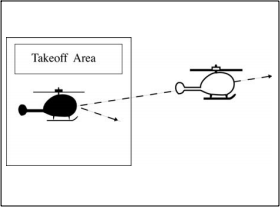
b. A preceding, arriving helicopter has taxied off the landing area.
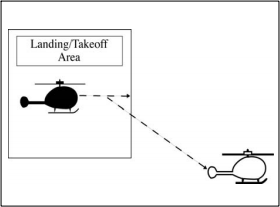
{Reference: FAAO 7110.65 3-11-3 “Helicopter Departure Separation.”}
3. Arrival Separation
Separate an arriving helicopter from other helicopters by ensuring that it does not land until one of the following conditions exists:
a. A preceding arriving helicopter has come to a stop or taxied off the landing area.
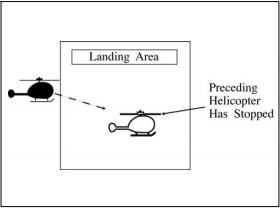

b. A preceding, departing helicopter has left the landing area.
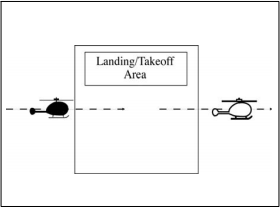
{Reference: FAAO 7110.65 3-11-4 “Helicopter Arrival Separation.”}
4. Simultaneous Landings or Takeoffs
Authorize helicopters to conduct simultaneous landings or takeoffs if the distance between the landing or takeoff points is at least 200 feet and the courses to be flown do not conflict. Refer to surface markings to determine the 200 foot minimum, or instruct a helicopter to remain at least 200 feet from another helicopter.
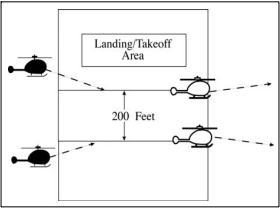
{Reference: FAAO 7110.65 3-11-5 “Simultaneous Landings or Takeoffs.”}
5. Landing Clearance
a. Issue landing clearance for helicopters to movement areas other than active runways, or from diverse directions to points on active runways, with additional instructions, as necessary. Whenever possible, issue landing clearance in lieu of extended hover-taxi or air-taxi operations.
PHRASEOLOGY-
MAKE APPROACH STRAIGHT-IN TO (location, runway, taxiway, helipad) ARRIVAL/ARRIVAL ROUTE (number, name, or code).
or
MAKE CIRCLING LEFT/RIGHT TURN TO (location, runway, taxiway, helipad) ARRIVAL/ARRIVAL ROUTE (number, name, or code).
HOLD SHORT OF (active runway, extended runway centerline, other).
REMAIN (direction/distance; e.g., 700 feet, 1 1/2 miles) FROM (runway, runway centerline, other helicopter/aircraft).
CAUTION (unlighted obstructions, wake turbulence, etc.).
CLEARED TO LAND.
CONTACT GROUND.
AIR TAXI TO RAMP.
NOTE-
Helicopter arrival routes are published on the Heli charts, available at www.skyvector.com, e.g. “LA West Heli.” Keep in mind that not all VATSIM pilots are familiar with these routes, so such a route is optional to assign if the controller’s confident in the pilot’s ability to fly the route.
b. If landing is requested to non-movement areas, an area not authorized for helicopter use, or an area off the airport, and, in your judgment, the operation appears to be reasonable, use the following phraseology:
PHRASEOLOGY-
LANDING AT (requested location) WILL BE AT YOUR OWN RISK (additional instructions, as necessary). USE CAUTION (if applicable).
TRAFFIC (as applicable),
or
TRAFFIC NOT A FACTOR.
c. Unless requested by the pilot, do not issue downwind landings if the tailwind exceeds 5 knots.
NOTE-
A pilot request to land at a given point from a given direction constitutes such a request.
{Reference: FAAO 7110.65 3-11-6 “Helicopter Landing Clearance.”}